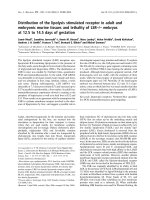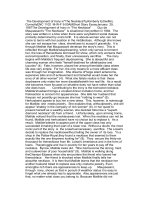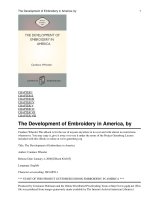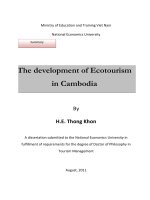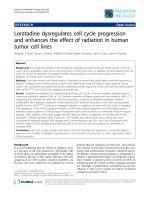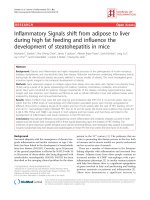Development of sphingosine kinase (SPHK) inhibitors and the role of sphingolipids in adult stem cell proliferation and differentiation 4
Bạn đang xem bản rút gọn của tài liệu. Xem và tải ngay bản đầy đủ của tài liệu tại đây (1.42 MB, 31 trang )
Chapter 4 Role of S1P in human BM- and AD- MSCs proliferation
122
CHAPTER 4 ROLE OF S1P IN HUMAN BM- AND AD- MSCS
PROLIFERATION
In Chapter 3, I discussed the regulatory effects of SPHK inhibitors in human BM- and
AD- MSCs differentiation, switching between the osteogenic and adipogenic pathways.
In this chapter, I present the results obtained in my studies on the role of S1P on the stem
cell proliferation.
S1P has been shown to have proliferative functions, promoting cell growth in various
types of cells (Zhang et al., 1991; Olivera and Spiegel, 1993), including in embryonic
stem cells (Pébay et al. 2005; Harada et al. 2004; Donati et al. 2007). Its structure is
shown below in Figure 4.1.
Figure 4.1 Structure of S1P, D-erythro
As was discussed in Section 1.1 SPHK and S1P, S1P has dual functions. It can act as an
intracellular mediator, and it can also act as an extracellular ligand to bind and stimulate
its-specific receptors, expressed on the same or nearby cells, in an autocrine or a
paracrine manner, to mediate various cellular responses (Spiegel and Milstien, 2003).
What interested us most is S1P role in the stem cells proliferation. So far, there are no
reports on S1P roles in human adult stem cells. Pébay et al. (2005) showed that S1P
could work synergetically with PDGF and promote human embryonic stem cells
Chapter 4 Role of S1P in human BM- and AD- MSCs proliferation
123
proliferation, as well as maintaining their stemness. However, human adult stem cells,
such as MSCs, are very different with embryonic stem cells in terms of cell properties
(such as differentiation potentials) and culture conditions (MSCs attach to the culture
flask while embryonic stem cells are usually cultured on the feeder-layer cells). Therefore,
it is of value to study, whether S1P may promote human BM- and AD- MSCs
proliferation, while maintaining their pluripotency.
Here, S1P alone, S1P with FBS (10% and 1%), and S1P with PDGF-AB, were tested to
investigate their roles in human MSCs proliferation. Cell proliferation was measured by
Quant-iT PicoGreen assay, which has been introduced in Section 3.1.5 Quantification of
the Stem Cell Growth (PicoGreen Assay). All cells used were from passage 2 to passage
9, at which passage they were considered to maintain their multipotency. Cells cultured
in S1P-supplemented media were then measured for their stemness maintenance by
checking their morphology change, the cell surface markers expression profile, and their
osteogenic differentiation potential. Finally, signaling pathways that S1P might trigger in
human MSCs proliferation were investigated.
4.1 MATERIALS AND METHODS
All chemicals, if not specially described, were purchased from Sigma-Aldrich, Singapore.
(Some methods used in this chapter are the same with those being used in Chapter 3,
which have been addressed in Section 3.1 Materials and methods, in Chapter 3)
Chapter 4 Role of S1P in human BM- and AD- MSCs proliferation
124
4.1.1 Delivery of S1P to Cells
S1P was first dissolved in methanol at 65°C as its solubility in other solvents is very poor
(Van Veldhoven et al., 1989). After S1P was dissolved, specific amounts of S1P were
aliquoted into tubes, and the methanol was evaporated by a stream of nitrogen. A suitable
amount of 0.1% fat-acid free bovine serum albumin (FAF-BSA) was then added into the
tubes to make 10mM S1P-BSA stock solutions. The stock solution was then diluted with
0.1% fatty-acid free BSA to generate the final working solutions.
4.1.2 Cell Surface Markers Expression (Flow Cytometry)
Human BM- and AD-MSCs (from two different donors) were analyzed by flow
cytometry for their expression of CD29, CD34, CD44, CD 45, CD71, CD73, CD90, and
CD105 using a Guava Personal Cytometer (Guava, Burlingame, Calif., USA). Briefly,
cells were removed from the culture, using 0.125% trypsin and washed once in 2%
FCS/PBS before counting. Cells were rested for 40 minutes in maintenance media before
1x10
5
cells were then aliquoted into a 96-well plate and pelleted at 450 x g for 5 min.
Pre-diluted antibody solutions in 2% FCS/PBS were subsequently added and cells were
incubated on ice for 20 min, followed by two washes in 2% FCS/PBS, before re-
suspension in 100 μl of 4% paraformaldehyde and incubation on ice for 20 min. Cells
were again washed twice in 2% FCS/PBS before being resuspensed in 200 μl of 2%
FCS/PBS and analysed on a GUAVA PCA-96 bench-top flow cytometer (Guava
Technologies Inc., USA). All samples were measured in triplicate for both types of cells.
Mouse IgG1 and IgG2a were used as isotype controls, to determine the positive cell
Chapter 4 Role of S1P in human BM- and AD- MSCs proliferation
125
populations (isotype cells< 5% positive cells). Five thousand events per antibody group
were counted in triplicate samples.
4.1.3 Calcium Assay
Cells were harvested by centrifugation, re-suspended in HERPES calcium (1.5mM)-
supplemented buffer and loaded with 5μM Fura2/AM (Molecular Probes, Invitrogen
Singapore). Human BM- and AD- MSCs were separated into samples of 0.2 million cells,
and were incubated at 37
o
C for 30 min and agitated every 15 minutes. Afterwards, cells
were washed twice and re-suspended in 2ml of HERPES calcium (1.5mM)-supplemented
buffer. Cells were then placed in a quartz cuvette and placed in a
spectrofluorophotometer (Shimadzu RF-5301 PC). Upon getting a stable basal reading,
cells were triggered by adding S1P. Readings were analyzed by the software provided by
the spectro-fluorophotometer manufacturer.
4.1.4 MAPK (P44/P42) Activation and IκB Phosphorylation
Cells cultured in 6-well plates were washed twice with 1x PBS and starved in serum-free
DMEM for half an hour. 1μM S1P was then added into the wells and incubated at 37°C
for 5min, 10min, 30min, and 60min to look for ERK activation. Human AD-MSCs were
triggered by 1μM S1P for 5 min and 10 min to look at IkB phsophorylation. Incubation
was stopped by placing the 6-well plates on ice and the cells were scraped out and
collected by centrifugation. Cell pellets were lysed and the protein concentrations in the
cell lysates were quantified. The same amount of proteins from each sample was loaded
onto SDS-polyacrylamide (10%) gel electrophoresis (SDS-PAGE) gels and analyzed by
Chapter 4 Role of S1P in human BM- and AD- MSCs proliferation
126
western blotting (more details below). For the primary antibody, phosphor-P44/42
MAPK (Thr202/Tyr204) mouse monoclonal antibody (Cell Signaling, #9106S), and
phosphor-IκB-α mouse monoclonal antibody (Cell Signaling, # SC-8404) were used. The
anti-mouse IgG HRP (Sigma, A4416) was used for the secondary antibody.
4.1.5 Western Blotting
The same amount of proteins from the whole cell extracts of each sample were loaded
and separated by SDS-PAGE, and the separated proteins were then transferred to PVDF
membrane. The membrane was probed with a suitable amount of primary antibody
overnight at 4 °C, followed by three 1xPBS washes, and each wash lasting five minutes.
After that, the membrane was probed with a proper amount of secondary antibody for
two hours, followed by another three 1xPBS washes, each wash lasting five minutes.
Signals were detected by incubating the membrane with SuperSignal
®
West Pico
Chemiluminescent Substrate (PIERCE, # 34080), which is an enhanced
chemiluminescent substrate for detection of HRP, for five minutes and then exposed to a
radiography film (CL-XPosure
TM
Film, PIERCE, # 34090). Alpha-tublin (primary
antibody: Alpha tublin mouse monoclonal antibody (Santa Cruz, #8035); secondary
antibody: anti-mouse IgG HRP (Sigma, A4416)) was used for equal loading control.
4.1.6 Statistical Analysis
Results are expressed as mean ± SD. Significance between mean values was determined
by Student’s t-test. Samples were analyzed by two-sample equal variance, and two-tailed
distribution, with a value of P< 0.05 considered significant.
Chapter 4 Role of S1P in human BM- and AD- MSCs proliferation
127
4.2 RESULTS
4.2.1 Human BM- and AD- MSCs Morphologies
Cell morphologies of human BM- and AD- MSCs under normal culture conditions are
shown in Figure 4.2.
Figure 4.2 Morphologies of human BM- and AD- MSCs in the normal culture media.
Human BM-MSCs (A) showed like fibroblast cells, while human AD-MSCs (B) showed
heterogeneous morphologies: some are “flat” , some are “fibroblastic” , and some
are “polar” . The microscopy magnification is 100x.
A
B
Chapter 4 Role of S1P in human BM- and AD- MSCs proliferation
128
Human BM-MSCs (Figure 4.2A) are more homogenous and look like fibroblast cells.
Human AD-MSCs (Figure 4.2B) show as a heterogeneous cell population, containing
three main types of morphologies: “flat” (round-head arrow shows), “fibroblastic” (flat-
head arrow shows), and “polar” (sharp-head arrow shows).
4.2.2 Roles of S1P in human BM- and AD- MSCs
4.2.2.1 S1P Receptors Expression in human BM- and AD- MSCs
As was stated in Section 1.1 SPHK and S1P, S1P functions as an extracellular mediator
are mainly through its five cell surface G-protein-coupled receptors: S1PR
1
, S1PR
2
,
S1PR
3
, S1PR
4
, and S1PR
5
. Thus, the mRNA expression of these five receptors in human
BM- and AD- MSCs was measured by real time PCR, and the results are shown in Figure
4.3. It shows that both human BM- and AD- MSCs, in normal culture condition,
expressed higher level of S1PR
1
, S1PR
2
, and S1PR
3
, but less of S1PR
4
and S1PR
5
.
Figure 4.3 S1P receptors expression in human BM- and AD- MSCs. Total RNA was
extracted from both types of cells, and cDNAs for S1PR
1
, S1PR
2
, and S1PR
3
were
prepared as serial controls for real time PCR. Serial controls of S1PR4 and S1PR5 used
in the real time PCR were extracted from human genomic DNA. Results are the average
+ the standard deviation of triplicate samples from at least three separate experiments.
Results for human AD-MSCs represent data from two donors.
S1PRs expression in human BM- and AD- MSCs
0
200
400
600
800
1000
1200
1400
S1PR1 S1PR2 S1PR3 S1PR4 S1PR5
S1PRs
copies per 3.5ng of total
RNA
BM-MSCs
AD-MSCs
Chapter 4 Role of S1P in human BM- and AD- MSCs proliferation
129
4.2.2.2 BSA effect on the MSCs growth
Since S1P was prepared in 0.1% FAF-BSA, the largest amount of the BSA used in all
experiments (1μl) was tested to investigate whether it alone had any effects on the MSCs
growth. Human BM-MSCs and human AD-MSCs were cultured in different culture
conditions (DMEM+10%FBS, DMEM only, and DMEM+1μl of 0.1% FAF-BSA) for 4
days, and the cell growth was detected by measuring the amount of DNA in each sample
with PicoGreen assay, which reflected the cell numbers in each sample. The results are
summarized in Figure 4.4. Cell numbers in the starting day (day 0) was also kept as a
control. Obviously, the amount of 0.1% FAF-BSA used in our study did not show to
promote the stem cells proliferation.
BSA function test in human MSCs (4 days)
0
0.5
1
1.5
2
2.5
3
day0 10% FBS DMEM 1ul BSA
culture conditions
cell growth (fold)
BM-MSCs
AD-MSCs
Figure 4.4 0.1% FAF-BSA function test in human BM- and AD- MSCs. Human BM-
and AD- MSCs were cultured in different conditions for 4 days, and cell growth was
measured by PicoGreen Assay. Day 0 represents cell numbers at the starting point. Data
from human AD-MSCs represent results from two donors. Results are the average + the
standard deviation of triplicate samples from at least three separate experiments.
4.2.2.3 MSCs growth promoted by S1P
Different dosages of S1P were then tested for their functions in human BM- and AD-
MSCs proliferation. Cells were cultured in serum-free DMEM medium, supplemented
Chapter 4 Role of S1P in human BM- and AD- MSCs proliferation
130
only with different amounts of S1P (100nM, 500nM, 1μM, and 5μM), and cultured for 4
days. The cells growth was measured by PicoGreen Assay, and the results are shown in
Figure 4.5.
Figure 4.5 Function of S1P in human BM- and AD- MSCs proliferation. Human BM-
and AD- MSCs were cultured in different conditions for 4 days, and cell growth was
measured by PicoGreen Assay. Data from human AD-MSCs represent results from two
donors cells. Results are the average + the standard deviation of triplicate samples from at
least three separate experiments. (*P<0.01, vs. “DMEM” in BM-MSCs; **P<0.05, vs.
“DMEM” in AD-MSCs. Student’s t-test).
Figure 4.5 shows that S1P alone, together with DMEM, showed to promote the cells
proliferation in human BM-MSCs only when the cells were cultured in DMEM+1μM
S1P. Moreover, 500nM and 1μM of S1P promoted around 1.2-fold and 1.3-fold of
human AD-MSCs growth, respectively, as compared with the cells growth in DMEM
alone. Additionally, it is shown that a higher amount of S1P (5μM) did not show to
promote human AD-MSCs proliferation.
S1P function on human MSCs proliferation
0
1
2
3
4
5
6
DMEM DMEM+10%FBS DMEM+100nM S1P DMEM+500nM S1P DMEM+1uM S1P DMEM+5uM S1P
culture conditions
cell growth (fold)
BM-MSCs
AD-MSCs
*
**
**
**
*
Chapter 4 Role of S1P in human BM- and AD- MSCs proliferation
131
4.2.2.4 MSCs growth Promoted by S1P and Serum
S1P, together with 10% FBS or 1% FBS, were tested for their roles in MSCs proliferation.
Human BM- and AD- MSCs were seeded in 48-well plates and cultured overnight to
allow for a proper cell adhesion. Cells were washed with 1xPBS and the culture medium
was changed to plain DMEM supplemented with 10% FBS or 1% FBS, with different
amounts of S1P. Cells were cultured for four days and cell proliferation was compared
and summarized in Figures 4.6.
S1P+FBS function in human BM-MSCs proliferation
0%
20%
40%
60%
80%
100%
120%
140%
10%FB
S
10
%
FB
S
+10
0nM
S
1P
10%FB
S
+50
0nM
S
1P
10%FB
S+
1uM
S1
P
1%F
BS
1%FBS
+
100nM S1P
1%FBS+500nM S1P
1%FBS+1uM S1P
culture conditions
cell growth
4.6A
*
*
**
S1P+FBS function in human AD-MSCs proliferation
0%
20%
40%
60%
80%
100%
120%
140%
160%
1
0%
F
BS
10%FBS+
1
00nM
S
1P
10%FBS
+5
00nM
S
1P
10%FB
S+
1uM
S1P
1%FBS
1%FBS
+
100nM S
1
P
1%FB
S+
500n
M
S1
P
1%FB
S
+1uM S1P
culture conditions
cell growth
*
*
**
**
**
4.6B
Chapter 4 Role of S1P in human BM- and AD- MSCs proliferation
132
Figure 4.6 Function of S1P and serum in human BM- and AD- MSCs proliferation.
Human BM-and AD- MSCs were cultured in different conditions for 4 days, and cell
growth was measured by PicoGreen Assay. Data from human AD-MSCs represent results
from two donors cells. Results are the average +
the standard deviation of triplicate
samples from at least three separate experiments. (*P<0.05, vs. 10% FBS; **P<0.05, vs.
“1% FBS. Student’s t-test).
Figure 4.6A shows the results from different amounts of S1P, together with 10% or 1%
FBS, on human BM-MSCs proliferation. It is shown that 500nM or 1μM of S1P, together
with 10% FBS, showed to promote about 20% and 23% more cell growth, respectively,
than that cultured with 10% FBS alone. However, only 1μM of S1P together with 1%
FBS, showed to promote around 25% more cell growth, than cells cultured with 1% FBS
only.
Figure 4.6B shows the functions of different amount of S1P combined with 10% or 1%
FBS on human AD-MSCs proliferation. It is shown that cell growth in 500nM S1P+10%
FBS, is 21% more than that cultured in 10% FBS alone; and cell growth in 1μM
S1P+10% FBS shows 30% more than that cultured in 10% FBS alone. Moreover, cells
cultured in 500nM S1P+1% FBS showed 38% more than cells cultured in 1% FBS alone;
and cells cultured in 1μM S1P+1% FBS showed 52% more cell growth than cells
cultured in 1% FBS alone. 100nM S1P did not show to promote cells growth when
combined with 10% FBS, but showed to promote around 30% more cell growth when
combined with 1% FBS.
4.2.2.5 MSCs Growth Promoted by S1P and PDGF-AB
1μM of S1P was combined with 20ng/ml PDGF-AB to investigate their functions in
human BM- and AD- MSCs proliferation. Human BM- and AD- MSCs were cultured for
Chapter 4 Role of S1P in human BM- and AD- MSCs proliferation
133
four days, and human AD-MSCs were also cultured for eight days in different culture
conditions, and the cell proliferation was detected by the PicoGreen assay. The results are
shown in Figure 4.7.
Figure 4.7 S1P and PDGF-AB function in human BM- and AD- MSCs proliferation.
Human BM- and AD- MSCs were cultured in different culture conditions and cells
proliferation were tested by PicoGreen assay. Results are the average + the standard
deviation of triplicate samples from at least three separate experiments. (*P<0.05, vs.
DMEM in human BM-MSCs; **P<0.05, vs. DMEM in human AD-MSCs. Student’s t-
test).
S1P+PDGF-AB function in human MSCs proliferation (4 days)
0
1
2
3
4
5
DMEM DMEM+10% FBS DMEM+1uM S1P DMEM+20ng/ml
PDGF-AB
DMEM+1uM
S1P+20ng/ml
PDGF-AB
culture conditions
cells growth (fold)
BM-MSCs
AD-MSCs
4.7A
*
*
*
*
**
**
**
**
S1P+PDGF-AB function in human AD-MSCs proliferation (8 days)
0
2
4
6
8
10
DMEM DMEM+10%
FBS
DMEM+1uM S1P DMEM+20ng/ml
PDGF-AB
DMEM+1uM
S1P+20ng/ml
PDGF-AB
culture conditions
cells growth (fold)
4.7B
**
**
**
**
Chapter 4 Role of S1P in human BM- and AD- MSCs proliferation
134
It is shown that 1μM of S1P had an additive effect when combined with 20ng/ml PDGF-
AB, in both human BM- and AD- MSCs (Figure 4.7A). In Figure 4.7B, after 8 days
culture, 1μM of S1P and 20ng/ml PDGF-AB promoted around 2-fold increase in cells
growth, compared to the cells grown in DMEM only.
4.2.3 Stemness Maintenance of Cells Cultured with S1P
After identifying S1P functions (S1P alone, S1P with serum, S1P with PDGF-AB) on
human BM- and AD- MSC proliferation, cells cultured in S1P-supplemented media were
tested for their stemness maintenance.
In particular, cells cultured from serum-supplemented or S1P-supplemented media were
compared for their morphologies, their cell surface markers expression profile, and their
osteogenic differentiation potential. It should be noted that only osteogenic differentiation
potential was selected as a “proof-of-principle” for the MSCs multipotency test.
4.2.3.1 Cell Morphologies Comparison
In most of the experiments, cells cultured in serum-free media seemed to be “elongated”
compared with those cultured in serum-supplemented media. However, the presence of
S1P partially restored the cell morphology observed in serum-free culture conditions.
This finding was observed for both human BM- and AD- MSCs, but more obvious in
human AD-MSCs. The results are shown in Figure 4.8.
Chapter 4 Role of S1P in human BM- and AD- MSCs proliferation
135
Figure 4.8 Human AD-MSCs morphologies in different culture conditions. Cells
were cultured from DMEM+10%FBS (A); DMEM (B); and DMEM+1μM S1P (C).
Magnificence: 120x. (the arrows show the cells morphology as “flat”).
DMEM+10%FBS
4.8A
DMEM
4.8B
DMEM+1μM S1P
4.8C
Chapter 4 Role of S1P in human BM- and AD- MSCs proliferation
136
In normal culture condition (DMEM+10%FBS), three different cell morphologies were
observed, as was shown in Figure 4.2B and Figure 4.8A. However, in serum-free medium
without any other supplements, most of the cells showed to be elongated, and the cell-cell
adhesion and the cells attachment to the culture flask looked different with the ones
cultured in serum-supplied media. However, 1μM S1P restored the morphology change
observed in human AD-MSCs, and the most obvious difference is that, cells with “flat”
morphology remained in 1μM S1P-supplied culture condition (the arrows shown in
Figure 4.8C), but not in serum-free media (Figure 4.8B).
4.2.3.2 Cell Surface Marker Expression Profile Comparison
Human BM- and AD- MSCs cultured in the serum-supplemented media or S1P-
supplemented media were compared for expression of several typical MSC cell-surface
markers. A series of cell surface markers were tested, and a reasonable hypothesis is that
if along several passages, the cell surface marker expression remained the same, it would
be convincing that the stem cells remained as stem cells.
Starting cells for human BM-MSCs were passage 6, and for human AD-MSCs (cells
from two different donors) were passage 4. Cells were equally grouped and cultured in
four different culture conditions: DMEM, DMEM+1μM S1P, DMEM+10% FBS, and
DMEM+10% FBS+1μM S1P. The cells were analyzed whenever they grew confluent.
However, cells cultured in serum-free DMEM ended up with not enough cells for the
flow cytometry analysis as they almost did not grow, and cells cultured in DMEM+1μM
S1P grew much slower than those from serum-supplied/serum and S1P-supplied ones,
which is consistent with the results we got from Figure 4.5. Since it took them too long
for the cells grew confluent, only the cells from DMEM+10%FBS and
Chapter 4 Role of S1P in human BM- and AD- MSCs proliferation
137
DMEM+10%FBS+1μM S1P culture conditions were analyzed by flow cytometry for
their expression of CD29, CD34, CD44, CD45, CD71, CD73, CD90, and CD105. Cell
surface marker expression profile in human BM-MSCs was tested in passage 7, passage 8,
and passage 9, and the cell surface marker expression profile in human AD-MSCs was
tested in passage 5, passage 6, and passage 7.
Mouse IgG1 and IgG2a were used as isotype controls, and five thousand events per
antibody group from triplicate samples were counted. The percentages of the expressed
cell surface markers in the cells are summarized in Table 4.1, and plots of receptor
expression of the last passage cells cultured in two different conditions are compared in
Figures 4.9 and 4.10.
(A) Human BM-MSCs:
Primary
Antibody
% of total events
P=7 P=8 P=9
ctrl S1P ctrl S1P Ctrl S1P
CD29
99.6 99.53333 94.87 91.86667 97.86667 96.66667
CD34
8.133333 3.6 9.07 8.766667 5.5 4.7
CD44
99.86667 99.56667 97.03 97.56667 99.46667 99.03333
CD45
6.966667 4.633333 6.23 7.966667 5.266667 5.466667
CD71
41.13333 47.03333 26.87 21.13333 9.133333 8.966667
CD73
99.86667 99.33333 90.33 96.56667 97.3 94.1
CD90
99.85 99.76667 98.23 98 99.3 99.03333
CD105
99.66667 99.2 91.73 92.06667 94.13333 92.83333
(B) Human AD-MSCs-donor 1:
Primary
Antibody
% of total events
P=5 P=6 P=7
ctrl S1P ctrl S1P Ctrl S1P
CD29
97.7 95.33333 99.73333 99.53333 99.6 99.63333
CD34
11.43333 6.833333 8.133333 6.733333 14.36667 12.83333
CD44
98.43333 99.26667 99.9 99.83333 99.9 99.76667
CD45
5.233333 2.833333 3.6 3.2 5.833333 3.466667
CD71
8.233333 6.966667 6.633333 4.8 29.63333 16.66667
CD73
90.8 96.33333 99.76667 99.8 99.66667 99.46667
CD90
98.1 97.2 98.63333 98.73333 99.53333 98.86667
CD105
97.23333 96.03333 98.6 97 99.4 99.13333
Chapter 4 Role of S1P in human BM- and AD- MSCs proliferation
138
(C) Human AD-MSCs-donor 2:
Primary
Antibody
% of total events
P=5 P=6 P=7
ctrl S1P ctrl S1P Ctrl S1P
CD29
95 93.96667 97.3 96 98.7 98.06667
CD34
4.266667 4.266667 4.666667 3.5 7.966667 5.166667
CD44
93.83333 97.8 99.3 99.63333 99.66667 99.56667
CD45
4.233333 3.966667 3.6 3.733333 5.533333 3.1
CD71
17.5 18.06667 10.6 9.133333 12.73333 7.966667
CD73
90.4 92.9 99.36667 98.53333 99.46667 99.4
CD90
98.06667 97.93333 99.46667 99.3 99.53333 99.46667
CD105
94.06667 88.73333 95.43333 93.63333 98.56667 98.63333
Table 4.1 Cell surface markers expression in human BM- and AD- MSCs. Table B
and C represent data from two donors cells of AD-MSCs. Mouse IgG1 and IgG2a were
used as the isotype controls and five thousand events per antibody group were counted.
Results are mean value from triplicate samples.
CD29 CD34
CD44
CD45
Chapter 4 Role of S1P in human BM- and AD- MSCs proliferation
139
Figure 4.9 Cell surface marker expression in human BM-MSCs from the last passage
(P=9). Red solid represents the isotype control, a black line represents the marker
expression from cells cultured in 10%FBS+DMEM (ctrl), and a green line represents the
marker expression from cells cultured in DMEM+10%FBS+1μM S1P. M1 is just an
arbitrary name, means marker 1. Triplicate samples for each antibody were used.
CD71 CD73
CD90
CD105
CD29
CD34
Chapter 4 Role of S1P in human BM- and AD- MSCs proliferation
140
Figure 4.10 Cell surface marker expression in human AD-MSCs from the last passage
(P=7). Red solid represents the isotype control, the black line represents the marker
expression from cells cultured in 10%FBS+DMEM (ctrl), and the green line represents
the marker expression from cells cultured in 10%FBS+1μM S1P+DMEM. M1 is just an
arbitrary name, means marker 1. Triplicate samples for each antibody were used.
CD44
CD45
CD71
CD73
CD90
CD105
Chapter 4 Role of S1P in human BM- and AD- MSCs proliferation
141
It is shown in Table 4.1 that the cell surface markers expression profile in the cells
cultured in serum-supplied media and serum/S1P-supplied media did not show much
difference in the same passage of the cells were analyzed, except that human BM-MSCs
(Table 4.1A) and AD-MSCs (donor 2) (Table 4.1C) lost their CD71 expression along the
three passages, and human AD-MSCs (donor 1) got more CD71 expression along the
passages (Table 4.1B). However, if CD71 expression in the cells of the same passage
from control condition (10%FBS+DMEM) is compared with those from
10%FBS+S1P+DMEM culture condition, there is not much difference from the two
culture conditions, indicating that the loss of CD71 in human bone marrow MSCs is not
due to the presence of S1P.
4.2.3.3 Osteogenic Differentiation Potential of human BM- and AD- MSCs
Cultured in Different Conditions
The osteogenic differentiation was chosen in this part of the study as a “proof-of-
principle” strategy to investigate whether human BM- and AD- MSCs, cultured in S1P-
supplemented medium, still retained their differentiation potentials. Due to the limited
number of the stem cells, only Alizarin Red S Staining was used to quantify the
osteogenic differentiation.
Cells were first seeded in T25 culture flask and cultured overnight to allow for a proper
cell adhesion. On the next day, cells were washed with PBS, and the media was added
that contained the following combination of supplements: DMEM; DMEM+10% FBS;
DMEM+1% FBS; DMEM+1 μM S1P; and DMEM+1% FBS+ 1μM S1P. Culture media
was changed every four days and cells were cultured for 12 days. After that, cells were
counted, and equal amount of cells were seeded in 48-well plates for 24 hours for
Chapter 4 Role of S1P in human BM- and AD- MSCs proliferation
142
adhesion. Cells obtained from the same culture condition were separated into two groups,
a group that did not received the differentiation cocktail, named the uninduced (cultured
in normal growth medium); and a group that received the differentiation cocktail, named
the osteogenic-induced group (cultured in osteogenic differentiation media (section
3.1.1.4
Stem Cells Osteogenic and Adipogenic Induction Culture). Cells were cultured for
a total of 28 days, then fixed and stained with Alizarin Red S. The Alizarin Red S
Staining quantification results are shown in Figure 4.11.
Alizarin Red Staining quantification of human AD-MSCs (type1) in different culture
conditions
0
0.05
0.1
0.15
0.2
0.25
0.3
0.35
0.4
0.45
DMEM DMEM+10%FBS DMEM+1%FBS DMEM+1uMS1P
DMEM+1%FBS+1uM
S1P
culture conditions
uninduced
osteogenic-induced
*
*
*
4.11B
*
Alizarin Red Staining quantification of human BM-MSCs cultured in different conditions
0
0.02
0.04
0.06
0.08
0.1
0.12
0.14
0.16
DMEM DMEM+10%FBS DMEM+1%FBS DMEM+1uM S1P DMEM+1%FBS+1uM
S1P
culture conditions
absorbance at 500nm
uninduced
osteogenic-induced
4.11A
Chapter 4 Role of S1P in human BM- and AD- MSCs proliferation
143
Figure 4.11 Alizarin Red S Staining quantifications of human BM- and AD- MSCs in
different culture conditions. Human BM- (A) and AD- (B & C) MSCs were cultured in
DMEM, DMEM+10% FBS, DMEM+1% FBS, DMEM+1μM S1P, or DMEM+1%
FBS+1μM S1P for 12 days. Equal amount of cells from each culture condition were
seeded in 48-well plates with normal culture medium, supplemented with (osteogenic-
induced) or without (uninduced) osteogenic differentiation media for another 28 days.
The cells were stained with Alizarin Red S, and quantified by detecting the absorbance at
500nm. Results are the average + the standard deviation of triplicate samples from at
least three separate experiments. * P<0.05, Student’s t-test.
Figure 4.11A shows the Alizarin Red S Staining quantification in human BM-MSCs
cultured under different conditions. It is shown that the cells cultured from all conditions
showed similar osteogenic differentiation potential. To our surprise, the cells cultured in
DMEM for 12 days did not show to lose the osteogenic differentiation potential.
Figure 4.11B shows the Alizarin Red S Staining quantification in type 1 human AD-
MSCs cultured from different conditions. It is shown that after 12 days, type 1 human
AD-MSCs cultured in DMEM lost about 1/3 of osteogenic differentiation potential as
compared to the cells cultured in DMEM+10% FBS. Cells cultured in the serum-reduced
media (DMEM+1% FBS) showed similar osteogenic differentiation potential with the
Alizarin Red Staining quantification of human AD-MSCs (type2) in different culture
conditions
0
0.05
0.1
0.15
0.2
0.25
0.3
DMEM DMEM+ 10%FB S DMEM+ 1%F BS DMEM+1uM S 1P D MEM+1%F BS +1uM
S1P
culture conditions
absorbance at 500nm
uninduced
osteogenic-induced
4.11C
*
Chapter 4 Role of S1P in human BM- and AD- MSCs proliferation
144
cells cultured in DMEM. However, 1μM of S1P restored most of the osteogenic
differentiation potential lost in type 1 human AD-MSCs (DMEM+1μM S1P+1%FBS vs.
DMEM+1% FBS, P<0.05), which is quite close to the potential in the cells cultured in
DMEM+10% FBS.
Figure 4.11C shows the Alizarin Red S Staining quantification in type 2 human AD-
MSCs cultured under the different conditions. As was stated in Section 3.2.3.1.1 Alizarin
Red S Staining for Mineralization in Human MSCs Osteogenic Differentiation, type 2
human AD-MSCs responded negatively to the osteogenic differentiation condition, which
is consistently supported in Figure 4.11C. Also, cells cultured in DMEM only showed to
lose around 1/3 of the osteogenic differentiation potential (DMEM vs. DMEM+10%
FBS). However, cells cultured in serum-supplemented or serum/S1P-supplemented media
showed similar osteogenic differentiation potentials.
4.2.4 Signaling Pathways Triggered by S1P
4.2.4.1 Intracellular Calcium Release
Calcium is a very important second messenger which can trigger many cellular responses,
including cell proliferation. In this study, intracellular calcium release, in human BM-
and AD- MSCs, was measured when exogenous S1P was added into the cells. Pertusis
toxin (PTX) was used to study the role of S1PRs involvement in S1P triggered cell
proliferation, as PTX is able to bind with Gi subunit of G-protein, and S1PRs are all G-
protein-coupled receptors and shown to bind/activate Gi subunit (Section 1.1 SPHK and
S1P).
Chapter 4 Role of S1P in human BM- and AD- MSCs proliferation
145
Cells were pre-treated or not with 100ng/ml and 300ng/ml of PTX for 30min. After a
stable calcium signal was obtained, 1μM or 10μM of S1P was added into the cuvette.
The calcium release results of human BM- and AD- MSCs at the different treatment
conditions are summarized in Figure 4.12.
Figure 4.12 S1P triggers intracellular calcium release in human BM- and AD- MSCs.
Cells were pre-treated with or without 100ng/ml or 300ng/ml PTX for 30min, followed
by adding 1μM or 10μM S1P (the arrow shows). Results were from both BM- and two
donors of AD- MSCs. Experiments were repeated three times.
Chapter 4 Role of S1P in human BM- and AD- MSCs proliferation
146
Figure 4.12 shows, that S1P triggered similar intracellular calcium release in human BM-
(Figure 4.12A) and AD- (Figure 4.12B) MSCs. 1μM S1P triggered a significant rise in
intracellular calcium in both types of cells, and 10μM S1P triggered higher intracellular
calcium levels than 1μM S1P did, demonstrating a dose-dependent effect. 100ng/ml, or
300ng/ml PTX showed to abolish around 80% of the calcium signal triggered by S1P,
suggesting that 100ng/ml PTX was enough to saturate all Gi subunits in the cells tested,
which implied that around 20% of intracellular calcium release triggered by 1μM S1P
was not through Gi subunits, i.e. not through S1PRs. Moreover, half amount of calcium
release triggered by 10μM S1P was not through its receptors in both types of cells, as
300ng/ml PTX abolished the same amount of calcium release as 100ng/ml PTX did. This
would suggest that S1P is primarily acting through its GPCRs; however, some of the
calcium response may be due to S1P penetrating the cells and act on, as yet unknown,
intracellular targets capable of triggering GPCR-independent calcium signals.
4.2.3.4 MAPK (P42/44) Activation and IκB Phosphorylation
MAPK (P42/44) signaling pathway plays a critical role in the regulation of cell growth
and differentiation (Crews et al., 1992). In this study, MAPK (P42/44) activity was
measured from cells stimulated with 1μM S1P, which was shown in previous results to
promote stem cell proliferation (Figure 4.5, Figure 4.6, and Figure 4.7). The cells were
washed in PBS and starved in serum-free DMEM for half an hour before 1μM S1P was
added into the cells and incubated for different times. The results are summarized in
Figure 4.13A, Figure 4.13C, and Figure 4.13D.

